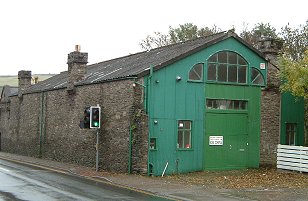Patrons:
Air Marshal Sir Ian Macfadyen
The Lieutenant Governor, His Excellency Lieutenant General Sir John Lorimer KCB DSO MBE
The Drill Hall, Peel Road, Douglas
Situated next to the Brown Bobby Petrol Station, on Peel Road in Douglas is the Wool Control Centre. It appears, at first glance, to be nothing of great importance, until you take a closer look.

In 1895, Major Robert Swan Stephen, commander of the Second Douglas Volunteer Rifles, purchased the Heritage, next to the Brown Bobby, from the Goldie family with the intention of building a drill shed for the Isle of Man Volunteers.
It was completed and opened in June 1896 and became the Corps Headquarters.
By the early part of the First World War, and with the influx of enemy aliens, 2 companies of IOM Volunteers had been formed and were based at the Drill hall. Following the formation of a third company, these men were billeted at Belmont House, Belmont Hill, and in the boarding houses on Belmont Terrace.
In March 1915, Officers and enlisted men who had volunteered for service overseas as members of the First Manx Service Company used the drill hall. They were waved off by a large crowd of family and friends on their way to the ship that was to take them to Liverpool for training.
It was in constant use by the IOM Volunteers throughout the rest of the Great War.
In 1938, when the 15th (Isle of Man) Light Anti-Aircraft Regiment TA (better known as “The Manx Regiment”) was formed, it again became the main recruiting office and headquarters. On the outbreak of hostilities in 1939,the unit was mobilised and sent to the mainland for defensive duties.
By May 1940, the L.D.V. (later re-named the Home Guard) had been formed in readiness for the possible invasion of the British Isles and the drill hall was manned by “ D” Company, 1st Battalion. “D” Company had the task of guarding Douglas Railway Station which was classed as one of the many “vulnerable” sites which might have been attacked by saboteurs. They continued to man the drill hall until they were stood down in November 1944.
After the war the Sea Cadets used the building for a number of years until it was taken over by the Isle of Man Government.
Internally, the main drill hall is still largely as it was. Although there has been some slight alteration, the wooden floors and walls and even the original fireplaces can still be seen. Downstairs the rifle range is still in use and the armoury’s heavy steel doors are still in place, definitely a case of “if it ain't broke”!
Outside, the big heavy wooden doors are still in place and next to the side door is a slab with the words “Armoury” engraved.
Hopefully the building is to be listed. Rightly so, as it has had all the main Manx military units through its doors. It truly is a historic building in every sense of the word.
